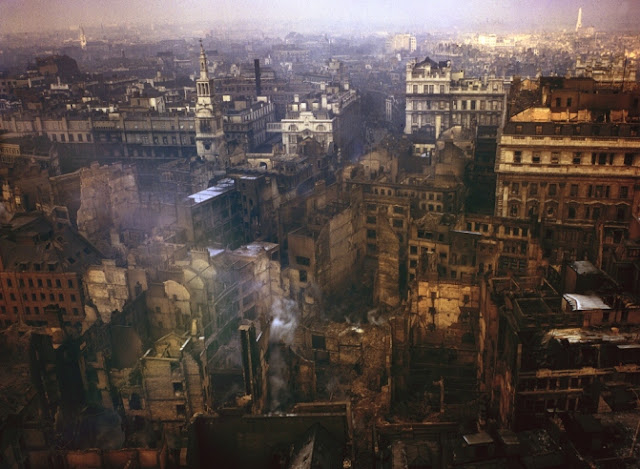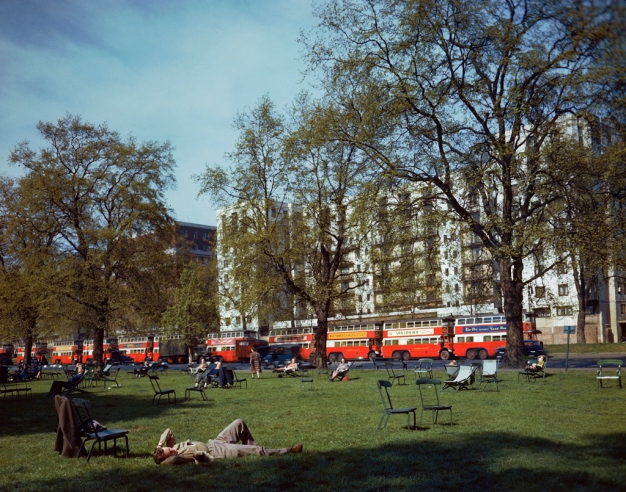Here,
LIFE.com presents color photos taken in London during the war, in tribute to the spirit of Britons who would not be cowed.
 |
| A view of London in 1940, with damage from German bombing raids. |
 |
| Workers clear debris from the lot where a home once stood, London, 1940. "These were the times," Churchill wrote in his war memoirs (also serialized in LIFE magazine in 1949), "when the English, and particularly the Londoners, who had the place of honor, were seen at their best. Grim and gay, dogged and serviceable, with the confidence of an unconquered people in their bones, they adapted themselves to this strange new life [of the Blitz], with all its terrors, with all its jolts and jars." |
 |
| Damage in London during The Blitz, 1940. "Away across the Atlantic," Churchill wrote in his memoirs, "the prolonged bombardment of London, and later of other cities and sea-ports, aroused a wave of sympathy in the United States, stronger than any ever felt before or since in the English-speaking world. Passion flamed in American hearts, and in none more than in the heart of President Roosevelt. I could feel the glow of millions of men and women eager to share the suffering, burning to strike a blow. As many Americans as could get passage came, bringing whatever gifts they could, and their respect, reverence, deep love and comradeship were very inspiring. However, this was only September, and we had many months before us of this curious existence." |
 |
| Britons work a "victory garden" in the midst of World War II, 1940. Countless numbers of these gardens sprang up in England, the U.S., Canada and elsewhere -- even Germany -- on private land and in public parks, as civilians pitched in to try and help the war effort by whatever means, no matter how seemingly small, available to them. |
 |
| A london bus rests in a massive crater left by a German bomb, 1940. "I felt," Churchill recalled, "with a spasm of mental pain, a deep sense of the strain and suffering that was being borne throughout the world's largest capital city. How long would it go on? How much more would they have to bear? What were the limits of their vitality? What effects would their exhaustion have upon our productive war-making power?" |
 |
| A London building ablaze during The Blitz, 1940. "To the Prussians of modern Berlin," LIFE wrote in January 1941, at the height of the Blitz, "old London is a hated symbol of all that makes Englishman superior people. For six months the Nazis bombed the British capital, by day and by night, without more than denting it. On the night of December 29, they tried to set fire to it. In that one night German bombers dropped an estimated 10,000 two-pound incendiary bombs." |
 |
| London smolders, 1940. "All the painfully-gathered German experience was expressed on this occasion," Churchill wrote of the infamous Dec. 29th raid. "It was an incendiary classic. The weight of the attack was concentrated upon the City of London itself. It was timed to meet the dead-low-water hour. The water-mains were broken at the outset by very heavy high-explosive parachute-mines. Nearly fifteen hundred fires had to be fought. The damage to railway stations and docks was serious. Eight [Christopher] Wren churches were destroyed or damaged." |
 |
| A view of London after a German air raid, 1940. "The Guildhall was smitten by fire and blast," Churchill recalled almost a decade later, in 1949, "and St. Paul's Cathedral was only saved by heroic exertions. A void of ruin at the very center of the British world gapes upon us to this day. But when the King and Queen visited the scene they were received with enthusiasm far exceeding any Royal festival." |
 |
| A man sits on a park bench in London, reading a book, 1940; a moored "barrage balloon" is visible in the background, while a second one soars high in the distance. Barrage balloons were remarkable devices designed to fly high enough to disable or even destroy enemy aircraft, which might fly into their ropes and metal cables. In WWII, barrage balloons were credited with bringing down more than 200 V-1 flying bombs -- or "doodlebugs," as the enormous (4,000-lb.) weapons were known in characteristically blithe British vernacular -- over England during the Blitz. |
 |
| A London Civil Defense Rescue crew helps remove injured and dead civilians from buildings after an attack German by a V-1 flying bomb, 1940. |
 |
| London, 1940. |
 |
| Life goes on in London, despite the destruction caused by German air raids, 1941. |
 |
| By 1944, when LIFE's Frank Scherschel took this picture in London, the nightly air raids had long ended, and it was increasingly clear that Hitler's delusional, megalomaniacal scheme to conquer all of Europe was destined to end in complete and abject defeat for the "Thousand Year Reich." |
 |
"The Germans," wrote LIFE in 1941, long before America entered the war, "are said to be greatly puzzled over London's willingness to take continual punishment without so much as a thought to surrender. The British, they think, are licked and refuse to accept the fact. But the British are not by any means licked and if, in the end, they win the war it will be due in no small way to the magnificent way in which the people of London are standing up to the siege.
via vintage-everyday.blogspot.com |














